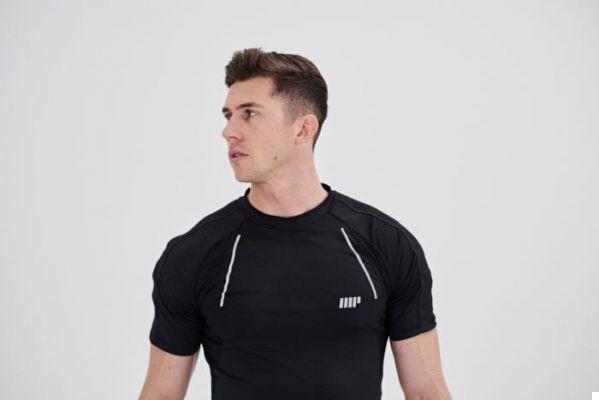Before asking how they are performed and which muscles are involved, perhaps it is better to clarify a little bit: the name knees to chest freely translated means knees to the chest, thus indicating a movement in which the knees are brought to chest height.
For this reason, according to the different functional schools, the knees to chest indicates a different exercise, in particular we can distinguish:
• knees to chest alla sbarra
• knees to chest in suspension (or with the swissball)
• knees to chest jump (anche noto come tuck jump)
Which one do we start from? Let's start with the first two, since they train the same area differently.
Knees to chest at the bar: execution, mistakes to avoid and trained muscles
Starting by grasping the bar slightly wider than the shoulders, assume the starting position by adding the shoulder blades.
Take a little momentum by pushing the hip forward and bringing the heels back; then contract the abdomen bringing the knees to chest height and then resume the initial position again. Performed dynamically, the K2Cs on the bar are very tiring, both from a muscular and cardio point of view.
It is also important to familiarize yourself with the small momentum that although in the first repetition it is very simple, in the following repetitions it needs a certain timing in order not to lose synchrony with the movement.

Important pay attention to some details like the initial position which must be solid and with the shoulder blades together, and not a simple salami hanging from the bar without the slightest muscle contraction.
It is also important to perform the momentum movement quickly (in order not to lose synchronism) but in a controlled manner, otherwise you risk arching your back excessively, causing some pain in the lumbar area.
This exercise presents itself as an excellent ally in the development of the core, especially in this version where the overload given by the force of gravity is maximum: we can see it in a certain sense as a progression of the reverse crunch.
Knees to chest at TRX (or swiss ball): execution, mistakes to avoid and trained muscles
Using the TRX or the swiss ball is not quite the same in terms of core stimulation, however we can treat this version the same in terms of mechanics for its explanation:
Position yourself with the back of your foot resting on the swissball (or on the TRX stirrups), resting on your hands. The arms must be well extended, the shoulders away from the ears by activating the lats.
The contraction of the core and buttocks must be maximum in this position, allowing me to create a straight line that goes from the legs to the torso.
Maintaining this suspended plank position is already tiring in itself. Then collect the legs bringing the knees towards the chest: the abdomen is involved to a greater extent in the collection movement.
As soon as you reach your chest, extend your legs again, assuming the starting position, and repeat for the preset number of repetitions.
What is the difference between using the TRX and the Swissball? It depends a lot on the TRX model (some have a single strap passing through an eyelet and free to slide inside it, which forms the two arms, while others have two straps attached separately to the eyelet): the Swissball needs continuous work of stabilization of the core which also has to cope with lateral rolling during execution.
On the other hand, the TRX has the possibility to raise or lower the fixing height of the feet, as well as to start from more or less advantageous positions for the recovery of the legs, thus modulating the intensity of the exercise according to the needs of those who use it. performs.
Knees to chest jump: execution, mistakes to avoid and trained muscles
Although it is an exercise without loads, the knee to chest jumps is a very dynamic exercise that requires coordination and an excellent state of health: for this reason I consider it an exercise for medium-high level athletes.
The starting position is in an upright position with the feet shoulder-width apart and the hands at the sides, the abdomen contracted, the shoulder blades adducted and the spine well extended.
Keeping the physiological curves and the gaze in front of you, descend into a quarter of a squat bringing your hands behind your hips., Then move on to the propulsive phase, where you need to push with all your strength towards the ground (as if we wanted feet abruptly into the ground) by jumping upwards.
During the flight phase, bring your knees to your chest and touch them with your hands. Then land on the toes, cushioning with the lower limbs.
Most of the work is done by the lower limbs (calves, tibials, quadriceps, hamstrings, buttocks), however, even if marginally, the core also remains involved in all those propulsion phases before jumping, gathering the knees to the chest and stabilization after landing.
The most common errors are to be found:
• in maintaining the activation of the core which provides us with stability in the starting and landing phases.
• in the landing phase which must be cushioned by the toes and not borne by the heel.
• stubbornly to perform a leap following a non-perfect landing, risking to put us in a position to land in an even more dangerous way.
Basically, knees to chest means "bring your knees to your chest" ... how you do it depends only on what you are training!


























